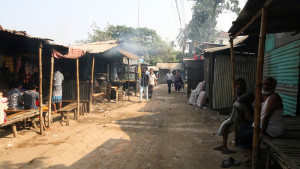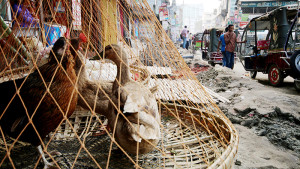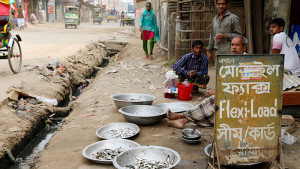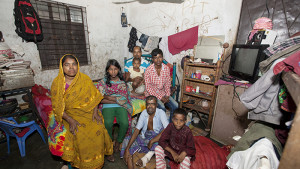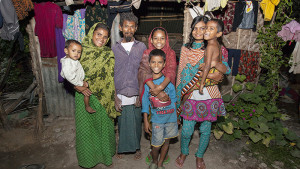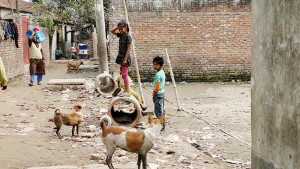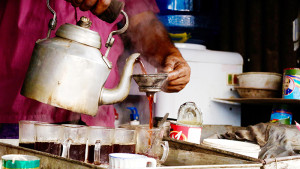Bangladesh is a beautiful country in South Asia, famous for its rivers, long beaches, garments industry and, sadly, poverty. The capital Dhaka is said to be the most densely populated city in the world, which means every piece of land is valuable and used for a purpose.
Many rural families become slum dwellers after failing to find their fortune in the city. They live in extreme poverty and can hardly afford to buy rice and pay the rent. One such area is only about 20 minutes’ bumpy rickshaw ride from the airport, and is called Gawair. This is the community in which the Maria Cristina Foundation works to provide education for children and adults. The aim of my visit was to gather data for the Foundation, but today I want to tell you about the conditions in the slum, which may rouse some of you to join me next time.
The slum is not a place for the fainthearted. It is dirty, noisy, smelly and confusing. The open sewers filled with garbage and unidentifiable liquids slowly move along the disheveled road. The shop owners have built tiny bridges to cross the sewers to their shops. Somehow I manage not to step into the sewers despite sharing the narrow path with chickens, cows, rickshaws, children and old men carrying everything from long bamboo sticks to chicken by their feet.
Carpenters are engraving flower patterns on cupboards and beds, tailors are making bed sheets and mattresses, chicken farmers are collecting eggs by the sides of the road and broken down rickshaws are being repaired right where they stopped. The numerous tea shops are filled with men passing time and chewing paan (betel leaf), their teeth red with the stuff, spitting red saliva on the street every now and then. There are entrepreneurial grandmas baking rice cakes by the side of the roads and old men selling fish that has stayed in the sunshine for too long. The smell of the fish is mixed with the raw meat hanging outside to attract potential customers and flies.
The rickshaws are nimbly moving along and somehow managing not to collide, leaving only millimeters between each other. And then there is the foreign blonde lady. Everyone is staring at me with amazement. I have tens of children following me and asking me what my name is. Some people approach me and ask me where I’m from. I soon realise that Estonia is not known in the slums of Dhaka and tell them I am from Zimbabwe; my husband’s country, and well-known in Bangladesh for its cricket team. I have never spoken so much about a sport I know nothing about.
The houses in Gawair are a mixture of compounds filled with tiny rooms with concrete floors and metal doors and makeshift shacks made of thin metal sheets with bare earth floors. The cooking facilities are usually outside – a fire powered by gas and little ovens made of clay. Toilets are typically somewhere near the kitchen and usually consist of a hole in the ground.
Most families live in a room, which is mostly taken up by a bed. Some have cupboards and some even have a desk, whilst others have goats in the house and little chicks in a box on top of their cupboard.Some families have a thin mattress on their bed, but others sleep on a bed made of planks of wood. The sheets, if there are any, are full of holes and stains; the families lucky enough to have a rattling fan – the best outdoor fans – in the ceiling put it on for me and warn me not to stand up as the low stooping fan will hurt me. Many of the roofs are made of cardboard, bamboo mats or asbestos that look perilously like they are about to cave in. If you are living in any of such condition or have anything made up of asbestos at your place, then I urge you to get in touch with SERS asbestos removal in Perth and leave it to their professionals to get rid of all the asbestos from your place.
It’s not unusual for 8, 9 or even 10 members of a family to have only one bed, and usually it’s the mother and daughters who sleep on the floor when the bed cannot fit everyone. Most families have electricity and some even have TVs, which are covered by a cloth when they are not being used to watch cricket or Bollywood dramas. The cleanliness of the homes varies a lot: some are extremely dirty and messy whilst others are humble, yet clean and tidy.
There are thousands of feral dogs roaming the streets and they keep multiplying. All the dogs are the same mongrel type and the females all seem to be pregnant or have just had puppies. They sleep most of the day and begin looking for food in the piles of rubbish and fighting with each other in the evening. Some of the dogs have scratched themselves so hard that they bleed and I cannot even imagine the types of bugs and diseases they carry. Nobody cares for these dogs, they are like vermin shooed away with kicks and blows. The slum-dwellers tell me that the dogs sometimes bite little children and they get sick.
Despite the daily struggles and always being in survival mode, the Bangladeshi people are very generous and welcoming. They love offering tea to their guests, and after a few cups of tea guests become friends. Everywhere I went I had to stop for 10 minutes and enjoy a small cup of sweet milk tea. I was even offered a cup of tea during a visit to a bank. I once asked for a coffee and got a tea with Nescafe in it…it was not my cup of tea.
The Maria Cristina Foundation will receive guests and volunteers in Dhaka any time and the community will be excited to spend time with you. For more info visit www.mariacristinafoundation.org
or e-mail marketing@mariacristinafoundation.org.
Words + Photosby: Katrin Winter

